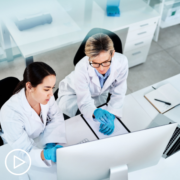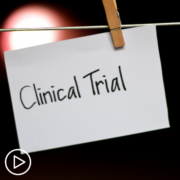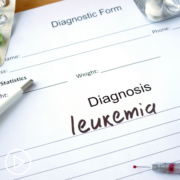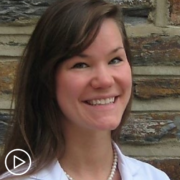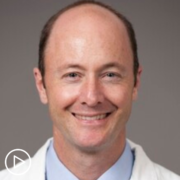What Patients Should Know About Developing MPN Treatments and Research from Patient Empowerment Network on Vimeo.
MPN expert Dr. Gabriela Hobbs provides an update on developments in myeloproliferative neoplasm (MPN) treatment and research. Dr. Hobbs explains how clinical trials and global research collaborations advance MPN care.
Dr. Gabriela Hobbs is a hematology-oncology physician specializing in the care of patients with myeloproliferative neoplasms (MPN), chronic myeloid leukemia and leukemia. Dr. Hobbs serves as clinical director of the adult leukemia service at Massachusetts General Hospital. Learn more about Dr. Gaby Hobbs.
See More From MPN Clinical Trials 201
Related Programs:
Transcript:
Katherine:
Hello and welcome. I’m Katherine Banwell, your host for today’s program. Today we’re going to discuss the advancements in MPN research through clinical trials. Before we get into the discussion, please remember that this program is not a substitute for seeking medical advice. Please refer to your healthcare team about what might be best for you. Well, let’s meet our guest today. Joining me is Dr. Gabby Hobbs. Dr. Hobbs, welcome. Would you please introduce yourself?
Dr. Hobbs:
Hi, how are you? Thank you so much for having me. My name is Gabby Hobbs. I’m the clinical director of the Adult Leukemia Service at the Massachusetts General Hospital in Boston. And I dedicate my clinical time and research efforts to the care of patients with Myeloproliferative Neoplasms.
Katherine:
Thank you so much for taking the time to join us today.
Dr. Hobbs:
Thank you.
Katherine:
I’d like to start by discussing your role as an MPN researcher. You’re on the front lines for advancements in the field. What led you to there and why is it so important to you?
Dr. Hobbs:
Many things in my life led me to becoming an MPN clinician. First, I wanted to be a clinical investigator since I was very little, and I read a Louis Pasteur book about – you know. And I was fascinated by the fact that you could be both a scientist and a clinician. And after that, I had phenomenal teachers and mentors. And I was really always drawn to patients with hematologic malignancies. I thought that that interaction was very intense and intimate.
And I was honored to be a part of that interaction. And then from a research perspective and from a scientific perspective, I very clearly remember seeing when the first targeted therapy, Imatinib, was approved when I was an undergrad. And I just thought that was the most fascinating thing. And so, I’ve basically continued to feel that way as I’ve gone through my training and I’m thrilled to be able to have actually become an MPN clinician so many years later.
Katherine:
With the American Society of Hematology or ASH meeting taking place this month, it demonstrates how researchers work together around the world to advance care.
Can you share with the audience how this collaboration works?
Dr. Hobbs:
Yeah. So, the American Society of Hematology meeting – or the ASH meeting – is really one of my favorite events of the year.
And it really highlights what you said. It is such a positive environment, and it’s so exciting to use that opportunity to talk to my collaborators from across the globe. And I really think that that’s where the scientific community shines because really all of us are actually trying to figure out how to work together and overcome sometimes a lot of obstacles – bureaucratic obstacles, regulatory obstacles – to make sure that we can share data, do it the right way. But really we always have one thing in mind.
And that is to be able to advance the care that we give our patients. And so, that collaboration and really that collaborative environment is always very positive. And I always come back home very energized from that. And then just seeing all my colleagues presenting all the wonderful things that they are working on and getting updates on their research is just an exciting environment.
Katherine:
In your view, why is it essential to present and share data at these larger conferences like ASH?
Dr. Hobbs:
So, for many different reasons. I mean, there are many different ways of presenting data that can be done through just publishing a paper. But the nice thing about conferences – and especially large conferences – is that you really get an opportunity to present work in progress. And some of these research projects may not end up turning into bigger projects or they may not become bigger trials. But all of them have at least an opportunity to learn something from them, whether or not they worked or they didn’t work.
Oftentimes when things are published in journals, especially the high-impact journals, we are seeing trials that had positive results. But sometimes we don’t see those smaller trials that never went anywhere. And so, having a forum when we can discuss work that’s ongoing, discuss about projects that are maybe having issues, all those things actually really help us to change our research questions or develop new research questions based on what’s working and also really what’s not working. And so, having this large forum to present all of that data, I think, is really, really important to helping us design future clinical trials and projects.
Katherine:
Yeah. Well, this is a great way to begin our clinical trial discussion, Dr. Hobbs. This research all requires MPN patients to participate in clinical trials. So, what should be considered when deciding whether to join a trial?
Dr. Hobbs:
What a great question. Many things need to be considered when joining a trial. And I think some patients are really eager to join a trial, and they just need to be aware that they may be either too healthy, or they may have other things going on that may not make them eligible.
And that’s okay. There are actually many ways of participating in research, even if it’s not a clinical trial that requires a medicine. For example, we often can send patients to what’s called a tissue bank where they have patients just give a sample of blood.
So, patients can participate in research in many different ways. When considering whether or not a patient should enroll in an actual clinical trial with a new medicine, I think it’s really important for the patients to be informed and to not be afraid to ask questions. First, what is a clinical trial? Second, what will this trial involve? Is this a drug that has never been given to people before, or is this a drug that has already undergone many different clinical trials? And this trial that’s being offered is a Phase III trial where the purpose of the study is to get the drug to be approved.
So, I think learning about the risk of the study, how it’s been utilized. And also the other more practical things. What is the time commitment of this clinical trial? How often are you going to have to be going to the office because of the clinical trial? Because there’s certainly a big investment in the part of the patients in terms of their time. Participating in a clinical trial most of the time requires more time than not participating in a clinical trial. That’s not always the case. There are some studies that definitely don’t require that many visits.
But most clinical trials will require at least something extra from the patient. And I think it’s really important to ask about that, to read the consent that’s given to the patients. Oftentimes these consents are very long.
And so, they can be overwhelming. I personally find them overwhelming. And I review a lot of those consents. And so, I think taking a minute to really ask those questions, speaking to the research staff, and getting the clarification on that is really important.
Like you said, it is impossible to approve new therapies and improve the care that we offer our patients without patients participating in the clinical trial. But that doesn’t mean that absolutely every single patient needs to participate in a clinical trial if it just doesn’t make sense for them. [14:17]
Katherine:
There have been huge developments in the last 10 to 15 years in the field of MPN. So, I’d like to dig a little deeper. We hear about the common driver mutations in MPNs like JAK2, CALR, and MPL. How are these being studied , and what is being discovered?
Dr. Hobbs:
Yeah. So, it’s amazing how in the last 15 years really so much has been discovered. You know. The JAK2 mutation was first published out in 2005 and calreticulin in 2013. So, those are relatively recent discoveries. And I think a lot of efforts has been put into learning about what these mutations are doing and how they lead to disease. And so, we have the JAK inhibitors, which block the signaling through a pathway called JAK-STAT. And all of these mutations will activate that pathway within cells.
And so, many of the approved drugs, for example, ruxolitinib (Jakafi), fedratinib (Inrebic), and pacritinib (Vonjo), work on blocking that pathway.
But since then we’ve also learned that there are other mutations and other pathways that are likely involved in the development of myeloproliferative neoplasms and also their progression. And so, what we’re seeing now is that many of the clinical trials that are being conducted don’t just target the JAK-STAT pathway or the pathway that’s influenced by these main mutations.
But also block other pathways to try to really block all the variant expression of signaling in the myeloproliferative neoplasms. And so, we’re trying to attack it by many different angles.
Katherine:
Yeah. Is there a possibility of specific targeted therapies at MPNs similar to those in AML such as FLT3 inhibitors?
Dr. Hobbs:
Absolutely. So, similarly to AML, we know that we have mutations in similar types of genes called tyrosine kinases. So, these are enzymes that are turned on and always active. And so, I think there is definitely hope that we can develop some targeted agents. For example, ruxolitinib or the other JAK inhibitors are similar. They’re tyrosine kinase inhibitors where they block an enzyme, specifically the JAK2 enzyme.
But I think that we can definitely do better and develop more specific inhibitors, for example, a molecule that just blocks the JAK2 mutation and not just every JAK2 molecule in every cell. Similarly to AML, there are mutations, for example, in enzymes called IDH.
And we have IDH inhibitors for AML. And there are some studies that are using IDH inhibitors for MPN. So, I think we’re going to continue to see more targeted therapies specific to the mutations that occur in MPN.
Katherine:
Yeah. Let’s talk about ET for a moment. Is there any research being done to help better manage this condition?
Dr. Hobbs:
Yeah. I would say that of the three MPNs, ET is certainly the one that has the least amount of drugs that are being currently studied for this group. But that doesn’t mean that there isn’t any research. Ropeginterferon (Besremi), which was recently approved in polycythemia vera, is now being studied in essential thrombocythemia.
So, I would expect in the next couple of years, if those trials are successful, to have ropeginterferon as a therapy to offer patients. There is also a clinical trial that we have at our site.
We’re using ruxolitinib or Jakafi for patients with ET that have symptoms of their disease to see if it can help them in the same way that it can help PV or myelofibrosis patients. So, there’s definitely some research going on in ET. But probably less than for PV and myelofibrosis.
Katherine:
Mm-hmm. While ET is typically well-managed, what patient type might benefit from joining a trial?
Dr. Hobbs:
It really depends on what the patient is experiencing. I think there are some patients that really are very asymptomatic and can expect to have an excellent outcome with their disease. But they can also participate in research, for example, by participating in a tissue bank and offering a sample of their blood or if they have a bone marrow by offering some bone marrow if there’s extra. Because that can really help to understand the disease biology, if a patient is going to progress from ET to myelofibrosis.
So, we can learn a lot from that. But then there are maybe some ET patients that need to be on a medication to reduce their blood counts or a cytoreductive agent.
And that’s a patient that could ask about participation in a clinical trial. For example, the ropeginterferon study or, like I mentioned, there may be some patients that maybe are already on a medication and their blood counts aren’t well controlled on the first drug that was used.
So, before considering switching to a second-line agent or a second medication, that could inquire with their clinician if there’s a clinical trial available for second-line use. Or those patients that have a lot of symptoms with ET, they could potentially be eligible for a study that addresses just symptoms.
Katherine:
Right. That’s really good news. I’m glad you talked about that.
Dr. Hobbs:
Mm-hmm.
Katherine:
There was recently an interferon approved for use in patients with PV. What other studies are showing promise for patients with PV?
Dr. Hobbs:
Yeah. So, we as a community, there’s been a lot of excitement about this new interferon that was approved, the ropeginterferon study. And there are still some ongoing studies utilizing ropeginterferon to see if we can use it differently. Because currently the way that that drug is approved is that it has to be titrated up very slowly to get to the maximum dose. So, that’s something that is still ongoing. In addition, there’s a new drug that’s being studied called Rusfertide (PTG-300) from a company called Protagonist. And this drug has been very interesting. It acts through iron metabolism.
And so far in preliminary results, it has shown that a lot of the participants that receive this medication no longer need phlebotomy. And I think what’s exciting about this is that phlebotomy is a very archaic way of treating patients.
And I hope that we can stop utilizing it. So, it’s nice to have a compound that’s specifically asking that question. And the other thing to keep in mind is that this drug has been used in combination with other drugs, which is really reflective of how participants or patients show up to clinics.
Some patients are not going to be on any medications. Some patients may be on hydroxyurea.
Some patients may be on an interferon. Some patients may be on Jakafi. And these trials allow participants to be on a variety of different medications. So, that’s an exciting new compound.
Katherine:
What about myelofibrosis, Dr. Hobbs? What advances are being made in the care of patients with this more advanced MPN?
Dr. Hobbs:
Yeah. So, in myelofibrosis, I would say it is almost difficult to keep track of how many clinical trials are currently open. So, in 2011, we had ruxolitinib approved, or Jakafi. That was the first JAK inhibitor. Since then we’ve had two more JAK inhibitors approved, fedratinib and most recently pacritinib. And we’re currently awaiting the fourth JAK inhibitor to be approved, and that’s called momelotinib.
And in addition to the JAK inhibitors, there are lots of other clinical trials underway right now that are either alone – a drug by itself or a drug in combination with ruxolitinib.
So, there are several Phase III studies. And the reason why that’s important is that after Phase III we usually see a drug approval. So, we can expect, hopefully in the next couple of years, to see many more drugs available on the market to treat patients with myelofibrosis. Some of those include agents that block different pathways within a cell. And that includes a drug called parsaclisib. There’s a drug called pelabresib, which is a BET inhibitor.
There’s another drug called navitoclax, which is a cousin of venetoclax (Venclexta), which is a drug that we’ve been using a lot in leukemia. So, there’s lots of different drugs that are being used in combination with Ruxolitinib. There’s also a drug called luspatercept (Reblozyl) that’s also been approved for myelodysplastic syndromes. And I suspect that that’ll be approved as well to help patients with anemia. So, really, there’s lots of drugs that are being studied right now. And I think the question that we’re all asking is, well, how are we going to use all of these different drugs? So, I look forward to seeing the results of those studies.
Katherine:
Mm-hmm. Will some drugs work better for some patients and others not?
Dr. Hobbs:
That is such a good question. And so, what I’m hoping to see is exactly that. I’m hoping to see that for patients, for example with anemia, perhaps we’re going to be using luspatercept and momelotinib. Perhaps we’re going to see that patients with certain mutations may respond better to certain medications like the BET inhibitors or navitoclax or the PI3 kinase inhibitor, parsaclisib. But as of now, we don’t have enough information.
We haven’t seen enough results of these studies to start to be able to know, you know, what is the patient that’s going to do better with two drugs versus one drug? And so, I think that over the next couple of years we’re going to start to have answers to those questions.
Katherine:
Yeah. I’d like to get specific about your research. What are you excited about right now?
Dr. Hobbs:
A few different things. There’s a clinical trial that I’ve been leading for several years now that got somewhat delayed due to the pandemic that’s utilizing ruxolitinib before, during, and after transplantation for patients with Myelofibrosis.
And that study is hopefully going to finish accrual in the next couple of months. So, I’m excited to see the results of that study. That study was presented at ASH of last year, the interim results of that study. And so far, we’ve seen exciting results. Patients have done well with transplant while receiving ruxolitinib.
We’ve seen that patients that have undergone transplant and have received ruxolitinib have had very low rates of a complication of transplant called graft-versus-host disease.
And that’s been very exciting, because we know that graft-versus-host disease is really very difficult to deal with after transplant. It can really impact quality of life. And so, that’s been exciting to see that we can help our patients to better tolerate this difficult treatment. On the complete opposite end of the spectrum, we’re treating patients that have low-risk essential thrombocythemia and polycythemia vera with ruxolitinib also to see if their quality of life can improve.
We know that patients with ET and PV live with a lot of symptoms. And often times patients that are considered low-risk can still have a lot of symptoms. And therapies haven’t really specifically been studied just to improve symptoms. Really, therapies are usually used to reduce the risk of having blood clots.
Katherine:
What about checkpoint inhibitors? You’ve done a study about that? Or it’s ongoing?
Dr. Hobbs:
Yes. Great question. So, a few years ago we utilized a checkpoint inhibitor called Pembrolizumab for patients with advanced myeloproliferative neoplasms. And that study was open at Mass General and also at Mount Sinai. We were worried that it wouldn’t be well tolerated. But it was actually very well tolerated. But unfortunately patients didn’t have a response. And a group at MD Anderson utilized another checkpoint inhibitor, Nivolumab, for these patients. And similarly they also didn’t see a response.
So, that was disappointing. However, I do think that there is a role for immunotherapy in patients with MPNs. I think that we probably need to think about utilizing the checkpoint inhibitors maybe earlier or maybe in combination with other agents. This has been done, for example, in solid tumors where two checkpoint inhibitors are sometimes utilized together. So, I think their area of investigation is still worth pursuing even though that was a disappointing result.
Katherine:
Yeah. Yeah. Any other research that’s going on that you’re doing?
Dr. Hobbs:
Yeah. We are looking forward to opening some clinical trials using different drugs in combination with ruxolitinib to offer different treatments to our patients up front. And so, instead of offering just single-agent JAK inhibitor, we can combine that with one of the new agents. And so, I’m looking forward to seeing how that’s going to work for my patients and to be able to offer them another treatment. I’m also thinking of developing a clinical trial for use in patients that have clonal hematopoiesis.
So, patients that have this entity called CHIP where they have a JAK2 mutation but maybe don’t have overt disease. We know that they have a high rate of transformation to an actual MPN. So, we’re working to develop clinical trials for those patients with the hope of maybe preventing the MPN from ever happening.
Katherine:
That’s great. We have some questions from the audience that were sent in prior to the program. Carl asks, “Are MPNs inherited? And why does one sibling develop an MPN and the other does not?”
Dr. Hobbs:
Great question. So, historically, we’ve always said MPNs are very rarely inherited. Now that we’re able to test for JAK2 mutations more commonly, we have, I think over the last decades, probably found that there are more families where the MPNs kind of run in the family.
Katherine:
Mm-hmm.
Dr. Hobbs:
Generally speaking, it’s very rare for MPNs to run in the family. I would say less than 10 percent of the case. And this is why a sibling can have an MPN and one doesn’t, even if they’re identical twins.
Katherine:
Is research being done to learn more about who may be at risk for developing an MPN?
Dr. Hobbs:
So, over the list, there’s been a lot of attention placed on this entity called clonal hematopoiesis of indeterminate potential. And through those types of investigations, we’ve learned that people can actually live with a JAK2 mutation for many years, even decades, before they develop a myeloproliferative neoplasm. And so, indirectly, I think that type of research will help us understand why some people get the JAK2 mutation to begin with and what else needs to happen in a patient’s life for that person to develop an MPN.
Because clearly there are many more people walking around with a JAK2 mutation than there are people with an actual MPN. So, there’s something else other than that JAK2 mutation that predisposes patients to then develop an MPN.
Katherine:
Angela has another question. “What are the long-term effects of JAK inhibitors? And what happens when JAK inhibitors are no longer effective?”
Dr. Hobbs:
Yeah. Great question. So, so far the patients that have been on JAK inhibitors for a long time don’t seem to have the development of additional toxicities that we didn’t know about. So, I’ll just comment on some of the things that we do know about. Weight gain is a common complaint that I have from patients, especially those that have polycythemia vera, because maybe they didn’t want to gain weight when they were put on a JAK inhibitor compared to the myelofibrosis patients who maybe had lost a lot of weight before being on a JAK inhibitor.
There are certainly higher risk probably of developing infections with some of the JAK inhibitors. And we see, for example, shingles reactivation being a common one. And there’s the concern of development of skin cancers, which has been seen with some JAK inhibitors. But generally speaking, long-term use seems to be safe. That being said, ruxolitinib, which is the oldest one to be approved, has only been around since 2011, so we don’t have decades worth of experience to know.
When JAK inhibitors stop working – to answer the second part of your question – until fairly recently we really didn’t have a whole lot to offer because there was only one JAK inhibitor. Now we have two others. We have fedratinib and also pacritinib. And we know from the studies that have been done with both of these agents that some patients that lose response to Jakafi, meaning that their spleen starts to grow or their symptoms start to come back, can be treated with these other JAK inhibitors.
And many patients will, again, have control of their spleen and symptoms. Now losing response to a JAK inhibitor can come in many different ways. And so, some patients may also develop signs of having leukemia or progression of their disease to leukemia. And, unfortunately, for those patients, being on another JAK inhibitor doesn’t make sense. So, those patients may need to receive other types of medications or a stem cell transplant.
Katherine:
Mm-hmm. Gary has two questions for you. The first is, “How useful is having a genetic panel done? Should all patients get molecular or genetic testing?”
Dr. Hobbs:
Great question. And I think that it is very important to have genetic testing.
And genetic testing involves more than just testing the JAK2 mutation. So, we know that the JAK2 mutation is the most common mutation in patients with MPN. But that being said, there are other mutations that also occur such as the calreticulin mutation and the MPL mutation. And so, I think having genetic testing that at least tests for those three mutations is very important so that we can actually help a patient know that they have an MPN. In addition to those three main mutations, many clinicians now have access to what’s called extended next-generation sequencing, where there’s a panel that tests for many different genes at the same time and can test for a variety of other mutations.
And this is particularly relevant for patients with myelofibrosis. As we know that having other mutations, like, for example, mutations in IDH or ASXL1 and others, can increase the risk of that disease in terms of its risk of transforming to leukemia or how long a patient may live with their myelofibrosis.
And so, I do recommend having extended next-generation sequencing done at least at diagnosis.
When I generally think about repeating that, if there’s something that looks like it’s changing within the patient’s disease, to be honest, also on the flipside of that argument, sometimes this next-generation sequencing will mostly contribute to adding anxiety and will not necessarily directly impact how a patient is treated. And this is particularly true in patients with PV and ET, where we’ll sometimes order these tests, and we get a bunch of mutations back, but we don’t know what to do with that information yet.
And so, as a researcher – not a clinician – as a researcher, I think it’s very important to have that information so that we can then do studies and understand the patterns of mutations and how that affects outcome. But as a clinician, and you as a patient, you need to really be aware of how that’s going to impact the patient in front of you and how that may impact you as a patient. Do you want to know if you have these mutations if nothing can be done about it? So, I would say, take a moment to reflect upon what I said and also to ask your clinician, how is this information going to help me? Do I need to have this information?
Maybe you want to have it done so that it’s in your record. But maybe you don’t necessarily want to know those results. And everybody’s very different. And I think it’s absolutely wonderful to talk to my patients about all the information. But there may be some patients that really are just, like, do the test but don’t tell me the results, because I know that I’m just going to be very anxious knowing that I have something that I can’t do anything about. So, just take a minute to talk about it with your doctors. I think that’s really important.
Katherine:
Yeah. Yeah. Here’s Gary’s second question. “Is allele burden a key predictor of progression?” And before you answer that, Dr. Hobbs, what does “allele burden” mean, and how does it impact progression?
Dr. Hobbs:
Great questions. And I hope that in the next couple years I have a much better answer for you. So, maybe I’ll come back again and maybe we can talk about this again. So, allele burden – just simply put – is basically, like, how many of the stem cells in your bone marrow have that JAK2 mutation. And that’s a concept that’s not obvious. So, not all of a patient’s blood with an MPN has that JAK2 mutation. There are some stem cells that have the JAK2 mutation and produce JAK2-mutated blood. And then there are some stem cells that are normal that just make normal blood and don’t have a JAK2 mutation.
And so, we can measure, what is a proportion of cells in the blood that has that JAK2 mutation? Now the next question should be very obvious and straightforward. But it really is not. So, what do we do with allele burden, and how do we measure that, and what does it mean if the allele burden goes up or it goes down? At this moment, we don’t necessarily know that. There have been some studies showing that maybe higher JAK2 mutation burden is maybe associated with progression or more with PV as opposed to ET.
And we’d all like to think that lowering that JAK2 mutation level or that JAK2 allele burden has to be good and maybe will decrease progression or improve survival. We haven’t seen that yet. And so, I think we’re all really waiting to see, what does it mean to lower that JAK2 allele burden? And then how often should we be measuring that? But right now we really don’t know.
Katherine:
Yeah. One more question for you. This one from Joseph. “I have PV and had adverse side effects from peginterferon alfa-2a (Pegasys). Is it likely that similar side effects would be experienced with Besremi?”
Dr. Hobbs:
Good question. It’s hard to know. And it really depends on the severity of the side effects that you had and the type of side effect that you had. In my experience, ropeginterferon or Besremii is very well-tolerated compared to the other interferons that were available. But if you really had a severe side effect it may be difficult to consider trying it. But it’s worth considering it. I’ve definitely had patients that have gone from Pegasys to ropeginterferon without any difficulty. But just because you had a bad side effect to one doesn’t mean that you’ll have a bad side effect to the other.
Katherine:
This is from Paul who lives in the United Kingdom. “How important is it to see an MPN specialist rather than a general hematologist? Right now I’m currently seeing a general hematologist who makes a note of my side effects but offers no coping strategies or solutions.”
Dr. Hobbs:
Yeah. That is a great question. And one with not one answer. I would say that if you’re an MPN patient and you have a clinician that treats you that feels comfortable treating you or you feel heard and you’re being offered different ways of dealing with symptoms or side effects, etc., then perhaps you don’t have to go out of your way to find an MPN clinician. And participating in webinars like this or learning online may be sufficient to know how to advocate for yourself and how to monitor your disease. That being said, I do think that it’s nice for patients to at least have a one-time opinion with a specialist.
And I would say that with the advent of virtual care, that has become increasingly more accessible. And so, if that’s something that’s available to you, that’s something you should consider. You know. Sometimes it’s very difficult to travel a long distance to meet with a specialist. But if you can avoid the travel by having a virtual visit, that often times can be very helpful in just knowing that you’ve met with somebody once. And then you can meet with that person periodically throughout your care can be very helpful. And I’ll tell you personally I see patients in the neighboring states to where I live.
And I like to see those patients periodically or communicate with their local providers. And so, it just helps to offer care that’s very specialized in maybe areas of the country that don’t necessarily have access to specialized care. So, I would encourage patients to seek that out if that’s something that they’re interested in because it’s really become, I think, easier to access the specialists.
Katherine:
Thank you for your thoughtful responses. And viewers please continue to send in your questions to question@powerfulpatients.org. Before we end the program, Dr. Hobbs, I’d like to hear why you’re hopeful about the future MPN care.
Dr. Hobbs:
Thank you so much. Those are great questions. I feel very hopeful about the future of MPN. As we mentioned at the beginning of this webinar, the scientific community and the MPN community of clinicians and investigators, it’s such a nice example of how scientists can work together to improve the care of patients. That I always feel very inspired by my colleagues. And now that ASH is around the corner, I can tell you that I feel very hopeful for the future of MPNs because I know that we’re going to learn about a variety of different clinical trials that are showing promising results that are going to ultimately impact the way that we are able to treat our patients with MPN.
And lastly, I feel very hopeful for the future of MPN because I know that the MPN community is very active. Patients participate in webinars like this, belong to different online groups, and are excellent advocates for themselves. I’ve seen firsthand in my clinic how when a drug gets approved, patients learn about new treatments online and come and ask for them. And so, I just feel very honored to be a clinician that is able to treat a group of patients that can advocate so well for themselves. And so, I definitely see lots of changes in the next couple years.
Katherine:
This is from Paul who lives in the United Kingdom. “How important is it to see an MPN specialist rather than a general hematologist? Right now I’m currently seeing a general hematologist who makes a note of my side effects but offers no coping strategies or solutions.”
Dr. Hobbs:
Yeah. That is a great question. And one with not one answer. I would say that if you’re an MPN patient and you have a clinician that treats you that feels comfortable treating you or you feel heard and you’re being offered different ways of dealing with symptoms or side effects, etc., then perhaps you don’t have to go out of your way to find an MPN clinician. And participating in webinars like this or learning online may be sufficient to know how to advocate for yourself and how to monitor your disease. That being said, I do think that it’s nice for patients to at least have a one-time opinion with a specialist.
And I would say that with the advent of virtual care, that has become increasingly more accessible. And so, if that’s something that’s available to you, that’s something you should consider. You know. Sometimes it’s very difficult to travel a long distance to meet with a specialist. But if you can avoid the travel by having a virtual visit, that often times can be very helpful in just knowing that you’ve met with somebody once. And then you can meet with that person periodically throughout your care can be very helpful. And I’ll tell you personally I see patients in the neighboring states to where I live.
And I like to see those patients periodically or communicate with their local providers. And so, it just helps to offer care that’s very specialized in maybe areas of the country that don’t necessarily have access to specialized care. So, I would encourage patients to seek that out if that’s something that they’re interested in because it’s really become, I think, easier to access the specialists.
Katherine:
Mm-hmm. Dr. Hobbs, thank you so much for joining us today.
Dr. Hobbs:
Thank you so much for having me.
Katherine:
And thank you to all of our partners. To learn more about MPNs and to access tools to help you become a proactive patient, visit powerfulpatients.org. I’m Katherine Banwell. Thanks for joining us today.





